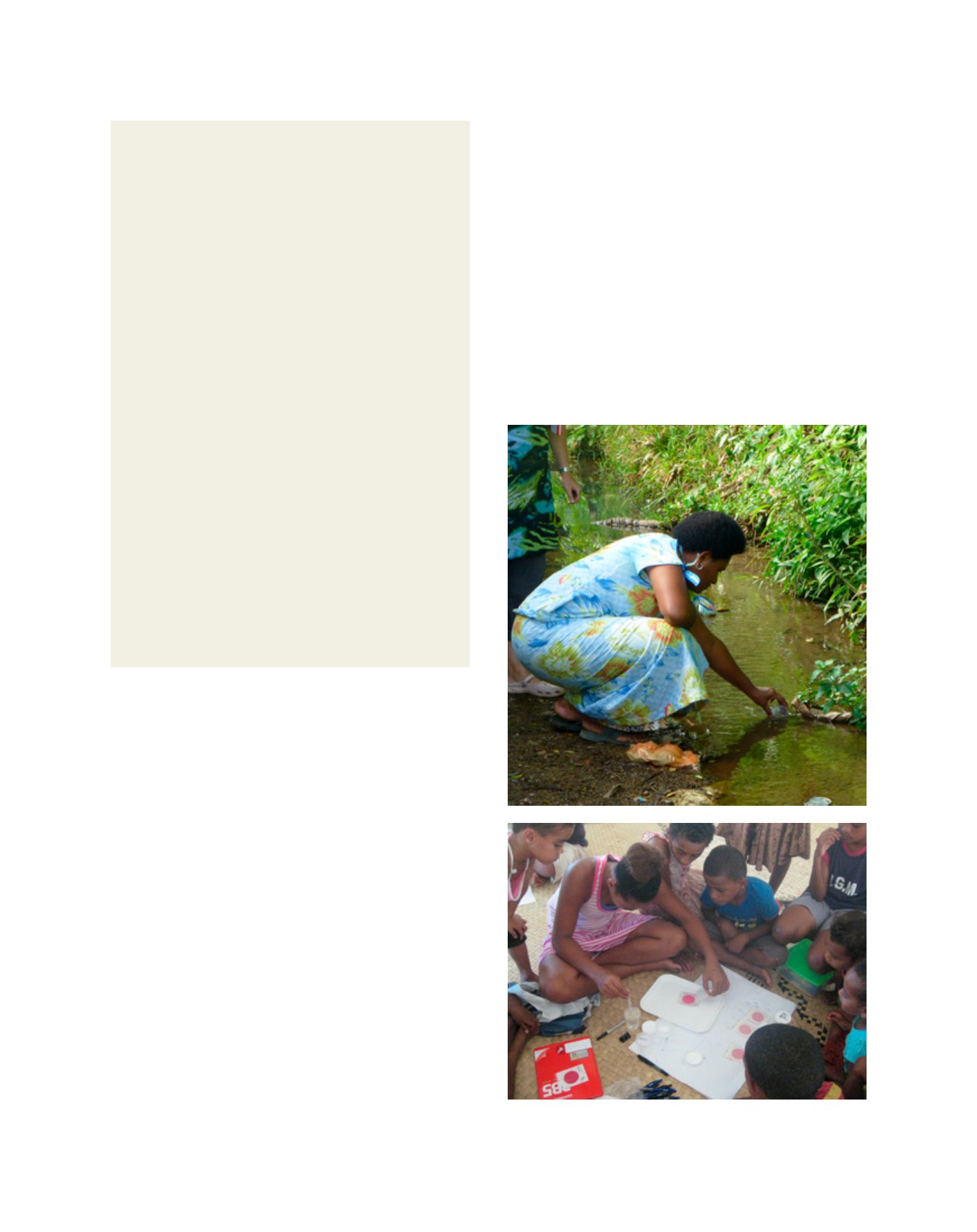

[
] 32
A B
et ter
W
or ld
supply capacity is limited, toilet flushing in some house-
holds in a village may compete with the basic drinking water
needs of others. Improved waterless toilet options therefore
need to be seriously considered where water supply capacity
and financial resources are limited. Use of flushing toilets
increases village water supply needs by 20–30%, and creates
a blackwater waste stream with high potential health risks.
Provision of adequate treatment facilities to manage
these sustainably is relatively costly for Fijian villagers and
requires competent and experienced technicians, engineers
and tradespeople who are able to effectively engage with
villagers, and are suitably remunerated for their work. These
skills are frequently unavailable in rural areas, and villagers
are reluctant to pay for such services. An appropriate policy
and regulatory framework is also necessary to promote
uptake of appropriate technical solutions and ensure they
are properly implemented.
Sustainable and effective village sanitation approaches
must be tailored to the particular site and soil characteristics
of a village or dwelling, and cognisant of the needs and finan-
cial resources of communities. Factors to consider include:
• Preferences of users, although this may shift with provi-
sion of improved knowledge and experience of alternatives
• Risk of contaminating surface and groundwater resources
used for drinking, and areas where people bathe, wash,
play, fish and gather shellfish, or may otherwise be exposed
• Surrounding population density, availability of suitable
land and coordination between neighbouring households
• Strength of village leadership and governance, and capac-
ity to operate and maintain systems
• Government policies and regulations.
A key finding fromwork carried out in Fiji has been the critical
importance of participatory capacity-building, in tandemwith
technical approaches, to raise and embed the understanding
of health and sanitation issues, enable appropriate choices
to be made, and mobilise village-wide actions. These can be
important drivers for the acceptance of village responsibili-
ties, and the prioritisation and uptake of improved water and
wastewater management systems and hygienic behaviours.
Involvement of women, who tend to take primary responsi-
bility for the health of their families, was especially important
for promoting action across the whole WASH spectrum.
Making visible the unseen
Water-borne gastro-intestinal diarrhoeal illnesses and secondary
infection of cuts, grazes and skin lesions, for example from scabies
and insect bites, are common health problems in Fijian villages.
Because of the hot, high-humidity climate, Fijian villagers, especially
the children, swim and bathe frequently in streams and lagoons
around villages. Communal bathing and clothes washing are often
also important social events in daily village life, and water from
these sources may also be used for drinking and cooking during
periods when piped or roof water supplies are unavailable.
Simple low-cost water quality testing was used alongside a variety
of other participatory activities to help assess water-borne health
risks in and around villages. With the involvement of women and
members of water and health committees, relevant surface and
drinking water quality sampling sites were identified, sampled, and
microbiologically assessed using simplified faecal indicator testing
methods – H2S paper strips, 3M Petrifilm™ or HyServe Compact Dry™
E.coli plate counts – and a field incubator. Feedback of results to the
village the next day, after 24 hours incubation, showed significant
faecal contamination of bathing areas and some surface water
source around the villages. This could be traced back to discharges of
blackwater from flushing toilets, and kitchen and bathroom greywater,
without appropriate treatment and disposal systems or necessary
maintenance. Small village pig enclosures also proved to be
significant sources of faecal contamination. Such cross-contamination
has the potential to substantially increase people’s exposure to faecal
microbes and related health and environmental risks.
Making visible the, otherwise unseen, microbiological state of
waters within and around the village has increased understanding of
wastewater sources and transmission pathways, and the potential
health risks of different drinking water sources and bathing areas
within villages. Direct visual assessment of the density of coloured
blotches formed by growing E. coli bacterial colonies on the plates
appeared to be more readily understood by villagers – and more
influential – than showing numbers on a graph. This helped build a real
world understanding of the links between water, sanitation and health.
Involvement of villagers in site selection, sampling of water resources and
testing the faecal microbiological status of those waters
Image: C.Tanner, NIWA
Image: C.Tanner, NIWA
















